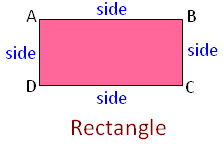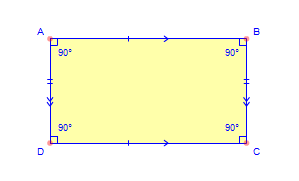How Many Right Angles are There in a Rectangle
Introduction:
In geometry, a polynomial is a closed figure. The intersection of two neighbouring lines defines a polygon's vertices, and the side is the line that connects the vertices. There are numerous types of polygons, depending on how many sides they have. A rectangle is a four-sided polygon. By examining its characteristics, we can determine a rectangle's total number of right angles. The vertex is the location where the two rays intersect. Angles are expressed using degrees (°).
Rectangle:
The internal angles of a rectangle, which has four sides, are all exactly 90 degrees.The two sides meet at an acute angle at each corner or vertex. Because its two opposite sides are identical lengths, the rectangle differs from a square.Rectangles are flat, two-dimensional shapes. We may easily represent a rectangle in an XY plane by using its length and breadth as the arms of the x and y axes, respectively.

The dimensions of a rectangle are length (L) and width (W) (W). Size variations exist for both length and width. Above is a diagram of a rectangle ABCD with the four sides AB, BC, CD, and DA, and the right angles A, B, C, and D. The width (W) of the given rectangle is used to specify the distance between B and C or A and D, whilst the length (L) is used to specify the distance between A and B or C and D. (L).
Features of a Rectangle:
The rectangle's characteristics are listed below:
There are four vertices and four sides.
Every vertex has a 90-degree angle.
The opposing sides have parallel and equal sides.
Intersect each other diagonally
The perimeter is equal to double the length plus the width of the object.
Its area is calculated as the product of its length and breadth.
All inner angles added together equal 360 degrees.
Area of Rectangle:
A flat surface with a specific shape occupies a certain amount of space, which is called the area. A "number of" square units are used in the calculation (square centimetres, square inches, square feet, etc.) The area of a rectangle is the maximum number of unit squares that can fit inside of it. Blackboards, canvases for paintings, laptop monitors, and other flat surfaces are a few instances of rectangular shapes. To determine the area that these objects occupy, use the rectangle's area formula. Consider a rectangle with dimensions of 4 inches by 3 inches, for instance. (Length x Breadth) square units are equal to the rectangular area.
Right angle:
The right angle is created when two straight lines cross at a 90° angle or when they are perpendicular at the intersection. Example: We see many right angles in the world around us. Right angles can be found in numerous items, including the corners of a room, a book, a cube, windows, and many others. A vertical and a horizontal line together can make a right angle in most cases. However, when diagonal lines cross each other, right angles are also formed. When a square, rhombus, or kite's diagonals are drawn, the angle at the intersection is 90 degrees or a right angle.

Conclusion:
Having four sides, the rectangle is a quadrilateral. It also features four 90-degree angles because it is four-sided. (Length x Breadth) square units are equal to the rectangular area. The diagonals of a rectangle are always the same length and have four sides. Rectangles have sides that are all perpendicular to one another, which means that any two of their sides can be joined together at a 90 degree angle. The internal angles of a rectangle total 360 degrees.The number of right angles in a rectangle is 4, which is equal to 360 degrees divided by 90 degrees. Therefore, a rectangle has four right angles.
Applications for Admissions are open.
As per latest syllabus. Physics formulas, equations, & laws of class 11 & 12th chapters
JEE Main Important Chemistry formulas
Get nowAs per latest syllabus. Chemistry formulas, equations, & laws of class 11 & 12th chapters
JEE Main high scoring chapters and topics
Get nowAs per latest 2024 syllabus. Study 40% syllabus and score upto 100% marks in JEE
JEE Main Important Mathematics Formulas
Get nowAs per latest syllabus. Maths formulas, equations, & theorems of class 11 & 12th chapters